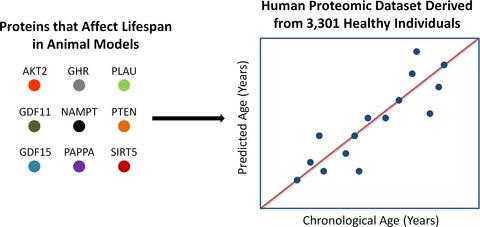当前位置:
X-MOL 学术
›
Aging Cell
›
论文详情
Our official English website, www.x-mol.net, welcomes your feedback! (Note: you will need to create a separate account there.)
Data mining of human plasma proteins generates a multitude of highly predictive aging clocks that reflect different aspects of aging
Aging Cell ( IF 7.8 ) Pub Date : 2020-10-08 , DOI: 10.1111/acel.13256 Benoit Lehallier 1, 2, 3 , Maxim N Shokhirev 4 , Tony Wyss-Coray 1, 2, 3, 5 , Adiv A Johnson 6
Aging Cell ( IF 7.8 ) Pub Date : 2020-10-08 , DOI: 10.1111/acel.13256 Benoit Lehallier 1, 2, 3 , Maxim N Shokhirev 4 , Tony Wyss-Coray 1, 2, 3, 5 , Adiv A Johnson 6
Affiliation

|
We previously identified 529 proteins that had been reported by multiple different studies to change their expression level with age in human plasma. In the present study, we measured the q‐value and age coefficient of these proteins in a plasma proteomic dataset derived from 4263 individuals. A bioinformatics enrichment analysis of proteins that significantly trend toward increased expression with age strongly implicated diverse inflammatory processes. A literature search revealed that at least 64 of these 529 proteins are capable of regulating life span in an animal model. Nine of these proteins (AKT2, GDF11, GDF15, GHR, NAMPT, PAPPA, PLAU, PTEN, and SHC1) significantly extend life span when manipulated in mice or fish. By performing machine‐learning modeling in a plasma proteomic dataset derived from 3301 individuals, we discover an ultra‐predictive aging clock comprised of 491 protein entries. The Pearson correlation for this clock was 0.98 in the learning set and 0.96 in the test set while the median absolute error was 1.84 years in the learning set and 2.44 years in the test set. Using this clock, we demonstrate that aerobic‐exercised trained individuals have a younger predicted age than physically sedentary subjects. By testing clocks associated with 1565 different Reactome pathways, we also show that proteins associated with signal transduction or the immune system are especially capable of predicting human age. We additionally generate a multitude of age predictors that reflect different aspects of aging. For example, a clock comprised of proteins that regulate life span in animal models accurately predicts age.
中文翻译:

人类血浆蛋白的数据挖掘产生了大量高度预测的衰老时钟,反映了衰老的不同方面
我们之前确定了 529 种蛋白质,这些蛋白质已被多项不同的研究报告过,它们在人血浆中的表达水平会随着年龄的增长而改变。在本研究中,我们测量了来自 4263 个人的血浆蛋白质组数据集中这些蛋白质的 q 值和年龄系数。对随着年龄显着增加表达趋势的蛋白质进行的生物信息学富集分析与多种炎症过程密切相关。一项文献检索显示,这 529 种蛋白质中至少有 64 种能够调节动物模型的寿命。其中九种蛋白质(AKT2、GDF11、GDF15、GHR、NAMPT、PAPPA、PLAU、PTEN 和 SHC1)在小鼠或鱼类中进行操作时可显着延长寿命。通过在来自 3301 个人的血浆蛋白质组数据集中执行机器学习建模,我们发现了一个由 491 个蛋白质条目组成的超预测老化时钟。该时钟的 Pearson 相关系数在学习集中为 0.98,在测试集中为 0.96,而中位绝对误差在学习集中为 1.84 年,在测试集中为 2.44 年。使用这个时钟,我们证明了有氧运动训练的个体比久坐不动的受试者的预测年龄更小。通过测试与 1565 种不同反应组通路相关的时钟,我们还表明与信号转导或免疫系统相关的蛋白质特别能够预测人类年龄。我们还生成了大量反映衰老不同方面的年龄预测因子。例如,一个由调节动物模型寿命的蛋白质组成的时钟可以准确地预测年龄。
更新日期:2020-11-23
中文翻译:

人类血浆蛋白的数据挖掘产生了大量高度预测的衰老时钟,反映了衰老的不同方面
我们之前确定了 529 种蛋白质,这些蛋白质已被多项不同的研究报告过,它们在人血浆中的表达水平会随着年龄的增长而改变。在本研究中,我们测量了来自 4263 个人的血浆蛋白质组数据集中这些蛋白质的 q 值和年龄系数。对随着年龄显着增加表达趋势的蛋白质进行的生物信息学富集分析与多种炎症过程密切相关。一项文献检索显示,这 529 种蛋白质中至少有 64 种能够调节动物模型的寿命。其中九种蛋白质(AKT2、GDF11、GDF15、GHR、NAMPT、PAPPA、PLAU、PTEN 和 SHC1)在小鼠或鱼类中进行操作时可显着延长寿命。通过在来自 3301 个人的血浆蛋白质组数据集中执行机器学习建模,我们发现了一个由 491 个蛋白质条目组成的超预测老化时钟。该时钟的 Pearson 相关系数在学习集中为 0.98,在测试集中为 0.96,而中位绝对误差在学习集中为 1.84 年,在测试集中为 2.44 年。使用这个时钟,我们证明了有氧运动训练的个体比久坐不动的受试者的预测年龄更小。通过测试与 1565 种不同反应组通路相关的时钟,我们还表明与信号转导或免疫系统相关的蛋白质特别能够预测人类年龄。我们还生成了大量反映衰老不同方面的年龄预测因子。例如,一个由调节动物模型寿命的蛋白质组成的时钟可以准确地预测年龄。


























 京公网安备 11010802027423号
京公网安备 11010802027423号